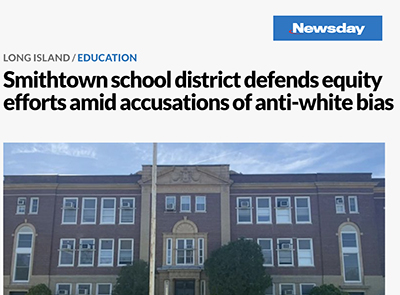Kerry Spooner
Last May, many of us closely followed the typically uneventful local school district board races. This year was going to be a bit different, we knew. The discourse and actions against establishing equity-based curriculums in school districts, mischaracterized as critical race theory, have been cropping up all across the country. As academic unionists, we value the freedom to pursue intellectual inquiry, critical thinking, empirical observation, honest dialogue and new ideas. We also have an interest in the K-12 education of our future students, and we are concerned about continued disruptions at school board meetings, from complaints about mask wearing to the imagined threat that critical race theory, or CRT, is being taught to kids in primary and secondary schools (it's not: it's taught in law schools and in some university programs). We need to pay attention to the potential wide-ranging educational and lifelong consequences for K-12 students in school districts like Smithtown where groups such as Save Our Schools fit into a larger "national movement against discussions of systemic racism in schools." Save Our Schools and No Left Turn are just a couple of the 165 groups bent on preventing classroom lessons on issues of race or "anything related to equity, diversity and inclusion." In a June 22, 2021, article “Juneteenth Meets Anti-Critical Race Theory Laws: Where Do Teachers Go From Here?” Jania Hoover notes, "more than 25 states have taken steps to restrict how schools can teach critical race theory or discuss racism and sexism." And five states including Texas "have already passed laws to this effect." Using CRT as a pretense, national and state policies are attempting to censor virtually all discussions on racism and sexism. Failure to provide K-12 education that introduces analytic skills needed to interrogate the social construction of identities, including the role of race and racism in our schools, isn't without historical context. And over the past 18 months, a number of historical events converged and the centuries long racial justice struggle quickened and expanded. During this time, George Floyd was murdered and the glaring light of a pandemic exposed the disparities among racial, ethnic and socioeconomic status in Covid-19 deaths. As a result, today many are for the first time hearing the term and learning about the intricately interwoven analytic frame work called critical race theory, which started in the 1970s under the leadership of Derrick Bell and included such thinkers as Kimberlé Crenshaw, Angela Harris, Richard Delgado, Charles Lawrence, Mari Matsuda and Patricia Williams. Harris, in the text Critical Race Theory, explains that
Loretta Ross, professor at Smith College, summarizes one of Crenshaw’s important contributions to CRT as it relates to the judiciary:
And in "Intersectionality, Critical Race Theory, and the Primacy of Racism: Race, Class, Gender, and Disability in Education," David Gillborn establishes the political possibilities of intersectionality in the realm of education:
Thus we can better see how denying intersectionality through a sustained, state-sanctioned practice of banning historical knowledge—referred to by some historians as historical negation, or "the failure to acknowledge historical reality"—serves to reinforce the narrative of white supremacy. Such a narrative mocks, intimidates and even tries to thwart the work of revisiting history; according to Critical Race Theory: "Revisionist history reexamines America's historical record, replacing comforting majoritarian interpretations of events with ones that square more accurately with minorities' experiences. It also offers evidence, sometimes suppressed, in that very record, to support those new interpretations." This is why we must closely follow these events as they concern educational practices shaping our future students and fellow citizens. Unreasonably restricting knowledge opposes educational principles. And academic unions are tasked with the work to protect academic freedom, which isn't so much to benefit colleges and universities, but faculty and the intellectual projects that benefit our students by offering them the latest in critical engagement, discussion and debate. |
